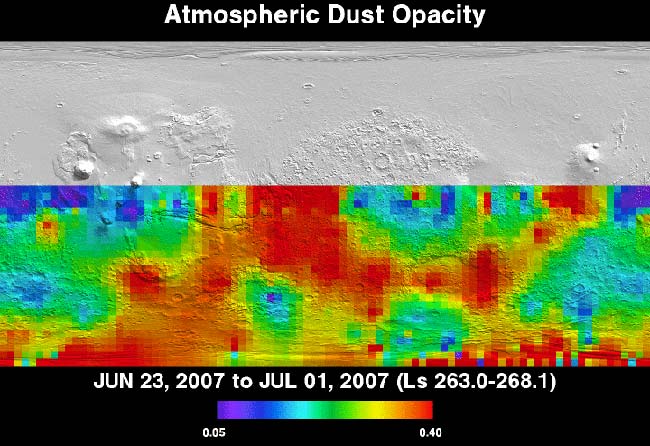Martian Dust Storm Creeps North

The enormous dust storm raging across Mars’ southern half has begun to creep into the northern hemisphere as well, new satellite images reveal.
Scientists are using the Thermal Emission Imaging System (THEMIS) on NASA’s Mars Odyssey orbiter to track the global Martian dust storm that erupted suddenly in late June. THEMIS is a multiwave camera sensitive to multiple wavelengths of both visible and infrared light.
The dust storm began in Mars’ heavily cratered southern hemisphere and swelled to encircle the entire planet in roughly a week. As winds swept dust into the atmosphere, the atmosphere warmed, creating a positive feedback that added to the storm’s power, helping it pick up even more dust. But this process can only go on for so long.
“When the dust becomes thick enough, it reflects more sunlight from the atmosphere, allowing the air near the surface to cool,” said Joshua Bandfield, research associate at the Mars Space Flight Facility at Arizona State University.
Dust storms, even global ones, are normal for Mars. “It’s southern summer in the southern hemisphere,” Bandfield said. "That’s when Mars lies closest to the sun and solar heating is greatest.”
If severe enough, dust storms can entirely obscure surface features on Mars. The first images from NASA of the storm reveal it hasn’t reached this level yet, although it has kicked up enough dust to reduce solar power to two robotic rovers, Opportunity and Spirit, currently on Mars.
“This storm isn’t as big or severe as the one in 2001,” Bandfield said. “THEMIS and other orbiters can still see the surface, despite the continuing dust activity.”
Breaking space news, the latest updates on rocket launches, skywatching events and more!
It’s uncertain how long the current storm will last, but it probably won’t disappear as quickly as it began. “Mars will remain dusty for at least a couple more months,” Bandfield predicts.
- Future Mars Explorers Face Dusty Challenges
- VIDEO: Pondering the End of the Rover Mission
- VIDEO: Red Dust Dangers
Ker Than is a science writer and children's book author who joined Space.com as a Staff Writer from 2005 to 2007. Ker covered astronomy and human spaceflight while at Space.com, including space shuttle launches, and has authored three science books for kids about earthquakes, stars and black holes. Ker's work has also appeared in National Geographic, Nature News, New Scientist and Sky & Telescope, among others. He earned a bachelor's degree in biology from UC Irvine and a master's degree in science journalism from New York University. Ker is currently the Director of Science Communications at Stanford University.
